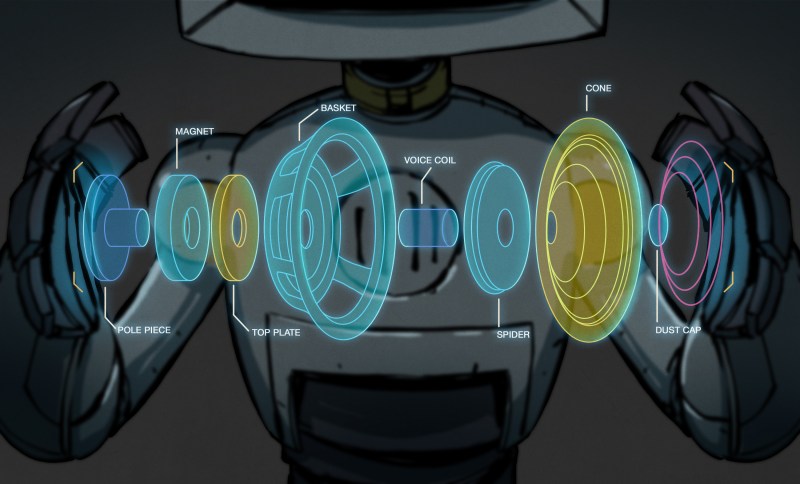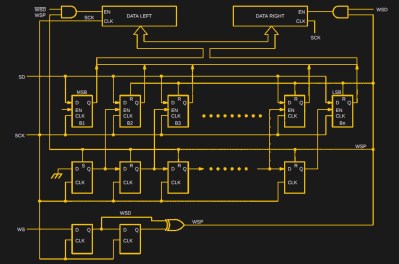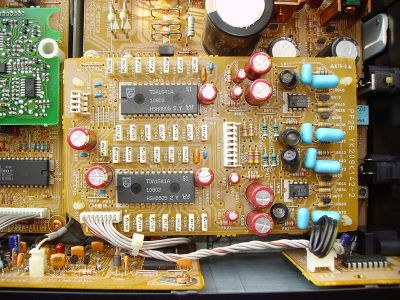
Our trip through the world of audio technology has taken us step-by step from your ears into a typical home Hi-Fi system. We’ve seen the speakers and the amplifier, now it’s time to take a look at what feeds that amplifier.
Here, we encounter the first digital component in our journey outwards from the ear, the Digital to Analogue Converter, or DAC. This circuit, which you’ll find as an integrated circuit, takes the digital information and turns it into the analogue voltage required by the amplifier.
There are many standards for digital audio, but in this context that used by the CD is most common. CDs sample audio at 44.1 kHz 16 bit, which is to say they express the level as a 16-bit number 44100 times per second for each of the stereo channels. There’s an electrical standard called i2s for communicating this data, consisting of a serial data line, a clock line, and an LRclock line that indicates whether the current data is for the left or the right channel. We covered i2s in detail back in 2019, and should you peer into almost any consumer digital audio product you’ll find it somewhere.
Making A DAC Is Easy. Making A Good DAC, Not So Much.

Remembering that i2s is a technology from the end of the 1970s, it’s a surprisingly simple one to create a DAC for. The original Philips specification document contains a circuit using shift registers and latches to capture the samples, which can be fed to a simple resistor ladder and filter to perform the conversion. This is an effective way to turn digital to analogue, but as with every audio component it carries with it a level of distortion.
If you look at the output of any DAC in the frequency domain rather than the time domain, you’ll find noise along with the spectrum of whatever signal it is processing. For instance, the sampling frequency will be there, as will a multitude of spurious mixer products derived from it and the signal. In an audio DAC all this out-of-band noise can manifest itself as distortion.
The problem faced by audio DAC designers is that the sampling frequency is relatively close to the signal frequency, so while the low-pass filter does its best to remove the offending spectrum, it has a difficult job. As an example back in 2020 we took a look at the CampZone 2020 badge, an audio playground that used a very cheap DAC to keep costs down. The Shenzhen Titan TM8211 i2s DAC is a single-chip implementation of something close to that Philips DAC circuit, and while it boasts an impressively low price, the noise is clearly audible on its output in a way that it wouldn’t be on a more expensive chip.
Shifting The Problem Upwards For A Better Sound

The solution found by the DAC designers of the 1980s and 1990s was to move that out-of-band noise up in frequency such that it could be more efficiently rejected by the filter. If you remember CD players years ago boasting “oversampling”, “Bitstream”, or “1-bit DAC”, these referred to the development of more advanced DAC designs that performed the shift upwards in out-of-band noise frequency by various different techniques. At the time this was a hotly contested marketing war between manufacturers as a CD player was seen as a premium device, from a position three decades later when a CD is something that has to be explained to children who have never seen one.
All of these are essentially sigma-delta DACs, and they approach the problem of moving the out-of-band noise upwards by producing pulse chains at a high multiple of the sample clock where the number of pulses corresponds to the value of the sample being converted. By sampling with lower resolution, but much faster, the associated out of band noise is shifted much higher up the frequency range, which makes the job of separating it out from the signal much easier. It can be decoded into an analogue signal by means of a fairly straightforward low-pass filter. These are the “Bitstream” and “1-bit” DACs advertised on those 1990s CD players, and what was once the bleeding edge of audio technology is now commonplace.
A Good DAC Can’t Compensate For A Poor Source
Although a good DAC makes a huge contribution to audio quality, we’ve assumed that the digital data comes from a source without much compression, such as a CD. CDs are now no longer mainstream, and the data is much more likely to have come from a compressed source such as an MP3 file or an audio streaming service. Compression is a topic in itself, but it’s worth making the point that the quality of the audio expressed on the data stream reflects the characteristics of the compression algorithm used, and no matter how good the DAC may be it can not make up for the quality of its source.
This series will return for its next installment, where we’ll address the concerns of the vinyl and tape aficionados who were screaming at the assumption that there would be a DAC in the signal chain. While once-dominant analogue audio formats such as the LP record and the cassette tape may now command a fraction of the market they once had, their rediscovery in recent years has led to a minor resurgence in their popularity. It’s still by no means unusual for a high-end audio system to have analogue source components, so they are very much worth a look.
0 Commentaires